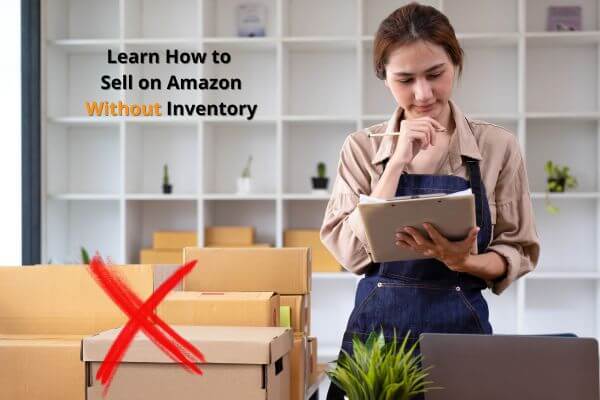This guide explores how to sell on Amazon without inventory, covering methods, strategies, and tools for running a successful Amazon business without traditional inventory hassles.
Selling on Amazon has transformed the e-commerce landscape, offering businesses and individuals a global customer base. It’s not just about buying and selling; it’s about innovative business models. One such model is selling without physical inventory, making entrepreneurship more accessible. While it might seem contradictory, with the right strategies, it’s not only possible but potentially very profitable.
Understanding Selling on Amazon Without Inventory
Selling on Amazon without inventory is a business model where sellers don’t keep products in stock. Instead, they source products from third-party suppliers who ship directly to customers. This is a form of dropshipping, eliminating upfront inventory costs and warehousing needs.
How It Works:
- Listing Products: Sellers list products on Amazon, sourcing information from third-party suppliers.
- Receiving Orders: When a customer orders a product, sellers receive the details.
- Order Fulfillment: Sellers purchase products from third-party suppliers, providing customer shipping details.
- Shipping: Third-party suppliers package and ship products directly to customers.
- Customer Service: Sellers handle customer service, including questions, complaints, and returns.
Selling without inventory reduces startup costs and operational overhead, allowing a wide range of product offerings. However, it relies on third-party suppliers’ reliability and quality.
Differences from Traditional Selling
Traditional Amazon sellers manage their own inventory, involving upfront investments, storage, listing, and order fulfillment. In contrast, selling without inventory lists products sellers don’t possess, relying on third-party suppliers for fulfillment.
The Role of Third-Party Fulfillment: Third-party fulfillment services, like Amazon’s Fulfillment By Amazon (FBA), play a crucial role. They store, package, and ship products on the seller’s behalf, reducing upfront costs.
Benefits:
- No need for physical storage space.
- Lower upfront costs.
- Focus on customer service and marketing.
Selecting a reliable third-party fulfillment service is vital for success.
Methods of Selling on Amazon Without Inventory:
- Dropshipping: Sellers don’t hold inventory, ordering products from third-party suppliers to ship directly to customers, reducing costs and risks.
- Amazon FBA: Sellers send products to Amazon’s fulfillment centers, which handles storage, packing, shipping, customer service, and returns.
Product Selection: Choosing the right products is crucial for profitability. Consider demand, profit margins, and competition. High-quality, reliable products are essential.
Strategies for Identifying Profitable Products:
- Use Amazon’s Best Sellers List.
- Focus on high-margin products.
- Consider product size and weight.
- Analyze product trends.
- Research competitors.
For advanced knowledge on how to sell on Amazon and to learn identify profitable products, consider enrolling in the Amazing Selling Machine to excel in online selling. Explore more about this training in our detailed article or try their 14-Day Free Trial.
Understanding Amazon’s Policies
Amazon prohibits certain items and requires accurate product listing information. Compliance is crucial to avoid legal issues and maintain a smooth selling experience.
Ensuring Quality Customer Service
Effective customer service is vital for seller-customer interactions. It can lead to higher satisfaction, positive reviews, and repeat business. Maintain clear communication and choose reliable suppliers.
Strategies for Maintaining High Customer Service Standards:
- Work with reliable suppliers.
- Communicate regularly.
- Respond promptly to inquiries and complaints.
- Be transparent about issues.
- Train your customer service team.
- Monitor customer feedback.
- Establish a clear returns policy.
Managing and Optimizing Amazon Sales
Regularly monitor sales performance, adjust product listings, and use strategies to increase sales. Maximizing visibility, conversion rates, and profits is the goal.
Importance of Regular Account Management:
- Monitor sales performance and identify growth opportunities.
- Improve product listings’ visibility and appeal.
- Adapt to changing market dynamics, customer preferences, and algorithms.
Strategies for Tracking and Increasing Sales
- Amazon Seller Central Reports.
- Use Keyword Tools like Jungle Scout and Helium 10.
- Pricing Tools like RepricerExpress.
- Quality Product Listings.
- Amazon Advertising.
- Customer Reviews.
- Inventory Management Tools (for dropshipping).
Selling on Amazon without inventory presents a unique opportunity in e-commerce. By understanding the basics, choosing the right products, providing excellent customer service, and managing sales effectively, you can build a successful Amazon business. The potential for profitability and scalability is significant, allowing you to cater to a wide customer base without the need for physical inventory. Amazon is an excellent platform for e-commerce, and with the right approach, you can thrive without holding inventory.




